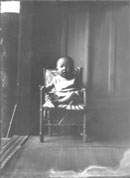PUT YOUR TONGUE OUT IN THE RAIN...
To define Butoh is to diminish the power of transformation inherent in this art.
I remember how Butoh dancers were amused when Westerners tried their hand at a definition.
I remember also how resistant they were to a discussion on rationality which, in their view, emasculated their art.
Butoh was always elsewhere, something else and had to be. The same is true of the chronology of the evolution and birth of Butoh. Mixing up the origins meant that it could be placed in the continuity of the various events of Japanese modern history or its traditions, from which it is only socially apart.
Let us say that Butoh is the fruit of paradox. But isn't Butoh the synthesis of past and present as well as oriental and western thought ? As the intellectual and avant-garde art critic Yoshida Yoshie has said, hints of resistance to impose modernisation are to be found in the words Ankoku Butoh.The ideogram bu which can also be read mai conjures up the early dance of Chamane priestesses, the Miko, who swirl around calling for rain to fall or the tamafuri, shaking body movements of the Chamane in a trance. Butoh emerged from the identity crisis which took hold of Japan after the war.
At a troubled time between an obsession for progress, as if it was getting its own back on history, and a determination to fall back on nostalgia for a Japan free from foreign interference, Butoh will shake the artistic circles out of their apathy and put down pointers for reflexion on the identity of cultural life…
|

